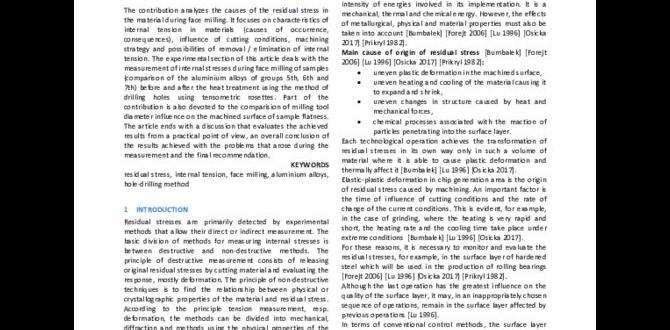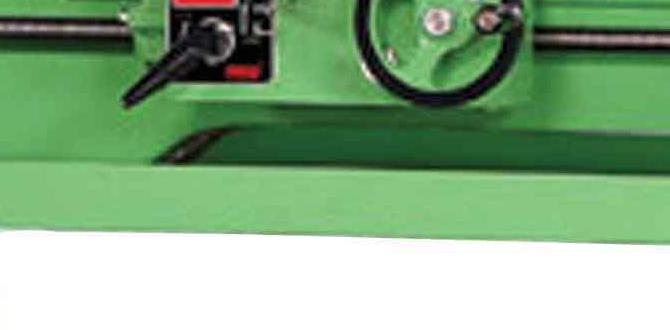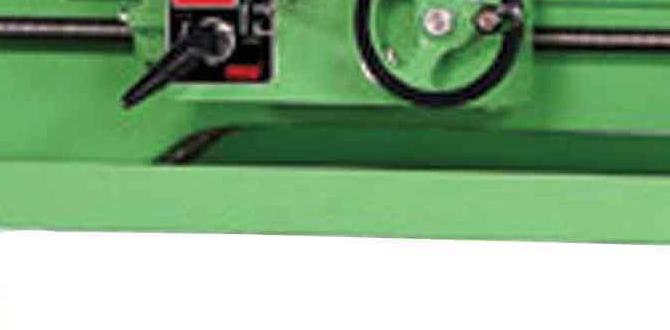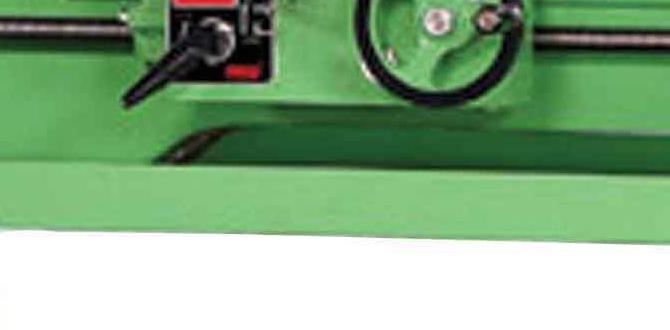Quick Summary: Selecting premium heavy-duty lathe machines means prioritizing robust construction, powerful motors, and precise controls to handle demanding industrial tasks reliably. For beginners, focus on understanding torque, stability, and essential features that ensure safety and excellent results when working with larger or tougher materials. Our guide breaks down what truly matters.
Hey there, fellow makers and aspiring machinists! Daniel Bates here from Lathe Hub. Thinking about stepping up your game with a lathe that can really chew through some serious material? It’s a big leap, and I get it – diving into the world of heavy-duty machines can feel a bit overwhelming at first. You’ve probably seen those massive lathes in workshops and wondered what makes them tick, or maybe you’re just tired of your current machine struggling with tougher jobs.
The good news is, you don’t need a degree in engineering to pick the right premium heavy-duty lathe. We’re going to break down exactly what “heavy-duty” really means and what essential power features you need to look for. We’ll cover everything from motor strength to build quality, making sure you feel confident in your choice and ready to tackle those larger projects safely and effectively. Let’s get your workshop ready for some serious work!
Why “Heavy-Duty” Matters for Your Lathe
When we talk about “heavy-duty” in the context of lathe machines, we’re referring to their capacity and build to handle bigger, tougher, and more demanding machining tasks. Think about it: you’re not just turning a small piece of soft wood; you might be shaping large metal components, creating substantial parts for machinery, or working with dense hardwoods.
A standard or hobbyist lathe is built for lighter work. It’s great for smaller projects, learning the ropes, or materials that don’t require a lot of force. However, when materials get larger, denser, or require significant material removal, a standard machine can quickly become inadequate. This is where the “heavy-duty” aspect becomes essential.
Choosing a premium heavy-duty lathe machine isn’t just about getting a bigger machine; it’s about getting a stronger, more stable, and more powerful machine. These machines are designed with specific features to ensure they can:
- Handle larger workpieces: Their swing (the maximum diameter they can turn) and bed length are designed for bigger projects.
- Withstand significant forces: They have the mass and construction to absorb vibrations and remain stable, even when taking deep cuts.
- Achieve precise results: Despite their power, they are engineered for accuracy, which is crucial for critical components.
- Operate safely for extended periods: Their robust design often includes better cooling and durability for continuous, heavy-duty use.
Ignoring these factors can lead to poor finish quality, excessive wear on your machine, potential safety hazards, and a lot of frustration. For anyone serious about precision engineering, industrial applications, or tackling ambitious woodworking projects, investing in a properly specified heavy-duty lathe is a game-changer.
Essential Power Features of Premium Heavy-Duty Lathes
When you’re looking at premium lathe machines for heavy-duty work, “power” isn’t just about horsepower. It’s a combination of several factors that work together to give the machine the muscle and control it needs. Let’s break down the key power-related features:
1. Motor Power (Horsepower – HP) and Torque
This is often the first spec people look at, and for good reason. For heavy-duty lathes, you’ll typically see higher horsepower ratings than on smaller machines. This is crucial for several reasons:
- Material Removal Rate: Higher HP means the motor can sustain the power needed to remove more material quickly and efficiently. This is vital when shaping large workpieces or working with hard materials.
- Consistent Speed Under Load: A powerful motor is less likely to bog down or slow excessively when you’re taking a heavy cut or working with dense materials. This consistency is key for a smooth finish and accurate dimensions.
- Torque: More than just raw HP, torque is the “twisting force” of the motor. High torque is essential for starting and maintaining rotation on heavy, unbalanced workpieces, or for overcoming the resistance of tough materials. Think of it like the difference between a small car and a truck – the truck has more torque to pull heavy loads.
What to Look For: For metalworking heavy-duty lathes, you’re often looking at 5 HP and up. For large woodworking lathes, power needs can vary, but you’ll still want a motor that doesn’t struggle. Always check the torque delivery, especially if specified, or look for machines known for strong performance under load.
2. Spindle Drive System
How the motor’s power gets to the spindle is just as important as the motor itself. Premium heavy-duty lathes often use robust drive systems to ensure smooth power transmission, precise speed control, and durability.
- Variable Frequency Drive (VFD): Many modern heavy-duty lathes, especially metal lathes, utilize VFDs. These electronic controllers allow for a very wide range of spindle speeds, often from very low to very high, with precise control. They also provide soft-start capabilities, which reduce shock on the motor and drivetrain. Crucially, VFDs can improve torque at lower speeds, which is a huge benefit for heavy work.
- Gearbox: Older or more traditional heavy-duty machines might rely on a gearbox with multiple speed ranges. While sometimes less convenient than a VFD for fine-tuning, a well-built gearbox provides significant torque multiplication at lower speeds, making it excellent for heavy material removal.
- Belt Drives: The type and quality of belts also matter. Heavy-duty machines use robust, often multi-ribbed belts designed to transfer power efficiently without slipping, even under high loads.
What to Look For: A VFD offers the best combination of speed range, control, and torque for most modern heavy-duty applications. If a gearbox is present, ensure it’s well-maintained and offers appropriate speed steps for your intended work.
3. Spindle Bore Size and Taper
This relates to the capacity of the machine to hold and process larger stock. The spindle bore is the hole that goes through the headstock spindle.
- Larger Bore: For heavy-duty metal lathes, a larger spindle bore allows you to pass stock material like bar stock directly through the headstock. This is critical for repetitive production work or turning long shafts. For example, a lathe with a 2-inch spindle bore can handle significantly larger stock than one with a 1-inch bore.
- Taper Type: The spindle taper (e.g., D1-camlock, A2, Morse Taper) determines how chucks, faceplates, and other workholding devices are mounted. Heavy-duty machines typically have larger and more robust taper sizes (like D1-8 or A2-8 for metal lathes, for instance) designed to withstand the forces involved and ensure secure, repeatable mounting of tooling.
To understand spindle tapers, you can often find guides on engineering sites. For example, this resource from Illinois Central College explains common spindle nose types found on metal lathes.
4. Machine Weight and Stability
This is a fundamental aspect of heavy-duty capability. The sheer weight of a machine contributes significantly to its ability to handle vibration and maintain accuracy.
- Bed Construction: Look for thick, well-ribbed cast iron beds. Cast iron is excellent at dampening vibrations, which is crucial for achieving a fine finish, especially when taking heavy cuts. A heavier, more rigid bed means less chatter and more precision.
- Overall Machine Mass: Heavier machines are inherently more stable. They resist the forces generated by cutting tools trying to deflect the workpiece or the machine itself. This stability is what allows for those deep, aggressive cuts associated with heavy-duty machining without sacrificing accuracy.
What to Look For: Don’t shy away from machines that look “overbuilt.” That extra weight and robust casting are what make them heavy-duty. A machine that feels solid and doesn’t shake excessively during operation is a good sign.
5. Power Feed Systems (for Metal Lathes)
While not directly “motor power,” the power feed system is how the machine’s motion is driven. For heavy-duty metal lathes, precision and reliability in power feeds are paramount.
- Carriage and Cross-Slide Feeds: These systems use gears and lead screws (or ball screws on high-end machines) to move the cutting tool along the length of the workpiece (carriage feed) or across it (cross-slide feed). For heavy-duty work, these mechanisms need to be robust, free of play, and capable of delivering consistent, precise feeds without slipping.
- Leadscrew and Feed Rod: The quality of the leadscrew used for threading and the feed rod used for turning feeds are critical. Heavy-duty machines will have substantial, well-supported leadscrews that can handle the loads without flexing or wear.
What to Look For: Smooth operation without excessive backlash is key. Check for sturdy gear trains and well-machined screws. For threading, precision is paramount, so the leadscrew quality is a major indicator of a machine’s true capability.
Choosing the Right Premium Heavy-Duty Lathe: A Step-by-Step Guide
Now that we understand the essential power features, let’s walk through how to pick the right premium heavy-duty lathe for your workshop. This process will help you cut through the noise and focus on what truly matters for your needs.
Step 1: Define Your Primary Use Case
Before you even look at machines, ask yourself: “What will I be doing with this lathe most of the time?”
- Metalworking: Are you making machine parts, tooling, or custom metal components? Look for features like robust cast iron construction, higher HP, larger spindle bore, precision gearboxes or VFDs, and fine feed controls.
- Woodturning: Are you turning large bowls, table legs, or furniture components? Focus on substantial cast iron beds for vibration dampening, variable speed control (often with a robust electronic system or belt changes), and a motor powerful enough to handle the inertia of large wooden blanks.
- Hybrid Uses: Some machines lean towards both. Understand the trade-offs. A metal lathe can often do light woodworking if adapted, but a woodworking lathe is generally not suitable for metalwork.
Be realistic about the size and type of materials you intend to work with. This will guide your selection of swing, bed length, and spindle bore.
Step 2: Determine Your Size Requirements
Lathes are often categorized by their swing (maximum diameter that can be turned over the bed) and their bed length (maximum length of workpiece). For heavy-duty work, you’ll generally need a larger machine.
- Center Height (Swing): Measure the largest diameter object you realistically think you’ll want to turn. Double that number, and then add a few inches for clearance. For example, if you want to turn a 15-inch diameter bowl, you’ll need a lathe with at least a 17-inch swing.
- Between Centers (Bed Length): Measure the longest workpiece you envision. Again, add a few inches for clearance.
Remember, a bigger swing often means a heavier machine, which is beneficial for heavy-duty work, but also requires more workshop space and potentially more robust flooring.
Step 3: Evaluate Motor Power and Drive System
Based on your defined use case and size, you can now look at power specifications.
- Horsepower: For metal lathes doing significant material removal, aim for 5 HP or more. For large woodturners, 1.5 HP to 3 HP might suffice if the machine is very well-built and has good speed control, but higher is always better for control and ability to hog material.
- Speed Control: VFDs offer seamless control and great torque at low speeds, which is ideal for metalworking and managing large wood blanks. For woodworking, well-designed belt-driven speed changes can also be effective if they offer a good range and are easy to adjust.
- Torque: If torque figures are available, compare them. Higher torque at lower RPMs is a sign of a powerful machine for heavy cuts.
Step 4: Inspect Build Quality and Stability
This is where “premium” really shows. Don’t just look at specs; imagine the machine in action.
- Cast Iron Construction: Look for solid, thick cast iron for the bed, headstock, and tailstock. Check for internal ribbing on the bed for added rigidity.
- Weight: Heavier machines are almost always more stable. If the manufacturer lists the machine’s weight, compare it to others in the same class.
- Fit and Finish: Examine how the parts are machined and fit together. Precision-machined ways (the guides for the carriage and tailstock) indicate better accuracy and longevity.
- Vibration Dampening: Ideally, the machine should have features designed to absorb vibration, such as a heavy base or rubber-isolated feet.
You can often find independent reviews or forum discussions where users talk about the rigidity and vibration damping of specific models. This user feedback is invaluable.
Step 5: Consider Workholding and Tooling Compatibility
How will you hold your workpiece? Premium heavy-duty machines come with robust workholding options.
- Chuck Mounting: For metal lathes, check the spindle nose type and size (e.g., D1-8, A2-8). Ensure it supports substantial chucks and faceplates that can handle powerful forces.
- Tooling Support: Lathes designed for heavy-duty work will typically have substantial tool rests (for wood) or tool post holders (for metal) that are rigid and can be precisely positioned.
- Tailstock Strength: The tailstock should be sturdy and capable of holding larger live centers or drill chucks without flexing.
You can check the specifications for the type and size of chucks and accessories the machine is designed to accommodate. Reputable manufacturers will often recommend specific workholding solutions.
Step 6: Research Brand Reputation and Support
When investing in premium heavy-duty machinery, brand reputation and after-sales support are crucial.
- Manufacturer History: Look for manufacturers with a long-standing reputation for building quality industrial or professional-grade machinery.
- Warranty: Understand the warranty terms. A good warranty on a heavy-duty machine indicates the manufacturer’s confidence in its durability.
- Parts Availability: For heavy-duty equipment, parts availability is critical. Can you easily get replacement parts if needed?
- Customer Reviews and Forums: See what existing owners say about the brand and specific models on machining forums or review sites.
Companies like Grizzly Industrial, Laguna Tools, JET, and Powermatic (among others, depending on the specific category and region) have established themselves with a range of machines, including options for heavy-duty work. Researching “best heavy duty metal lathe reviews” or “best heavy duty wood lathe reviews” can point you to reputable sources like Popular Mechanics for tool reviews, which often cover different classes of machines.
Step 7: Consider Your Budget and Long-Term Value
Premium heavy-duty lathes are an investment. They will cost significantly more than their hobbyist counterparts.
- Initial Cost: Factor in the machine price, shipping, and any necessary accessories (tooling, chucks, dust collection for wood).
- Total Cost of Ownership: Consider longevity, maintenance, and potential resale value. A well-chosen heavy-duty machine can last decades and retain a good portion of its value if cared for.
- Return on Investment: If this machine is for a business or serious hobby, think about how its capabilities will impact your productivity, project scope, and potential earnings.
It’s often better to buy the best quality machine you can afford that meets your current and near-future needs rather than buying a cheaper machine that you’ll outgrow quickly. For instance, a robust benchtop metal lathe might seem appealingly priced, but if you frequently need to turn parts larger than 10 inches diameter, a Gap Bed Lathe or a heavier floor-standing model will be a much better long-term investment.
Comparing Premium Heavy-Duty Lathe Types
Within the category of “premium heavy-duty lathes,” there are specific types that cater to different needs. Understanding these distinctions will help you narrow down your search.
Metal Lathes for Heavy Duty
These are built for precision and power in metalworking. They are characterized by their rigid construction, high torque motors, and ability to take significant cuts.
Key Features:
- Robust cast iron construction (often heavily ribbed).





